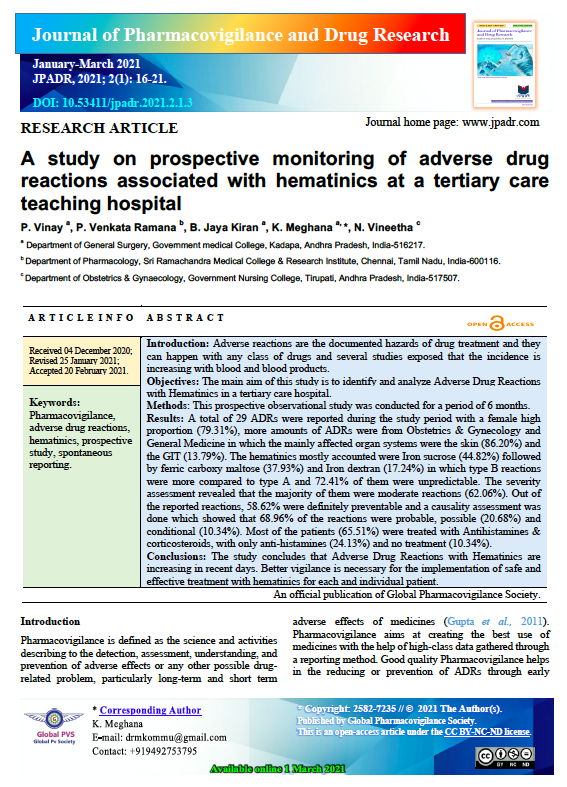A study on prospective monitoring of adverse drug reactions associated with hematinics at a tertiary care teaching hospital
Abstract
Introduction: Adverse reactions are the documented hazards of drug treatment and they can happen with any class of drugs and several studies exposed that the incidence is increasing with blood and blood products.
Objectives: The main aim of this study is to identify and analyze Adverse Drug Reactions with Hematinics in a tertiary care hospital.
Methods: This prospective observational study was conducted for a period of 6 months.
Results: A total of 29 ADRs were reported during the study period with a female high proportion (79.31%), more amounts of ADRs were from Obstetrics & Gynecology and General Medicine in which the mainly affected organ systems were the skin (86.20%) and the GIT (13.79%). The hematinics mostly accounted were Iron sucrose (44.82%) followed by ferric carboxy maltose (37.93%) and Iron dextran (17.24%) in which type B reactions were more compared to type A and 72.41% of them were unpredictable. The severity assessment revealed that the majority of them were moderate reactions (62.06%). Out of the reported reactions, 58.62% were definitely preventable and a causality assessment was done which showed that 68.96% of the reactions were probable, possible (20.68%) and conditional (10.34%). Most of the patients (65.51%) were treated with Antihistamines & corticosteroids, with only anti-histamines (24.13%) and no treatment (10.34%).
Conclusions: The study concludes that Adverse Drug Reactions with Hematinics are increasing in recent days. Better vigilance is necessary for the implementation of safe and effective treatment with hematinics for each and individual patient.
Downloads
References
Amrita, P., Simar, P. S., Vineet, K. (2012). Status of adverse drug reaction reporting by health care professionals of Delhi. Indian journal of pharmacy practice, 5(4), 42-50.
Gupta, S. K. (2011). Text book of Pharmacovigilance. 1st edition. Jaypee Publishers, 213-219.
Haines, H. M., Meyer, J. C., Summers, R. S., & Godman, B. B. (2020). Knowledge, attitudes and practices of health care professionals towards adverse drug reaction reporting in public sector primary health care facilities in a South African district. European journal of clinical pharmacology, 76(7), 991–1001.
Jayesh, K. M. R., Kajal, S., Srivastav, A. K. (2016). Pharmacovigilance: a review article. Innovative journal of medical sciences, 4(5), 6-7.
Lihite, R. J. (2017). A study on adverse drug reactions in a tertiary care hospital of Northeast India. Alexandria journal of medicine, 3(1), 151-156.
Mohanta, G. P. (2016). Text book of Pharmacovigilance-Concepts and practices. 1st edition. Pharma med press, 2016, 23-29.
Nour, S., Plourde, G. (2019). Chapter-2 Pharmacovigilance. Pharmacoepidemiology and pharmacovigilance, 5(3), 7-23.
Ratan, J. L., Mangala, L., Sukirti, D. (2017). A study on adverse drug reactions in a tertiary care hospital of northeast India. Alexandria journal of medicine, 3(1), 151-156.
Sneha, G., Sowmya, N., Prem, K. G. (2016). An observational prospective study on prevalence and monitoring of adverse drug reactions in tertiary care teaching hospital. BJPR, 1(2), 01-09.
Sriram, S., & Dinu, C. (2019). Role of Healthcare Professionals in Reporting Adverse Drug Reactions & Monitoring and Documentation of Suspected Adverse Drug Reactions. International journal of pharmaceutical science invention, 8(2), 18-39.
Suyagh, M., Farah, D., & Abu Farha, R. (2015). Pharmacist's knowledge, practice and attitudes toward pharmacovigilance and adverse drug reactions reporting process. Saudi pharmaceutical journal : SPJ : the official publication of the Saudi Pharmaceutical Society, 23(2), 147–153.
Thomas, D., & Zachariah, S. (2018). Knowledge, Attitude and Practice of Pharmacovigilance in Developing Countries. pharmacoepidemiology and pharmacovigilance, 9(5), 177-193.
Visacri, M. B., de Souza, C. M., Sato, C. M., Granja, S., de Marialva, M., Mazzola, P. G., & Moriel, P. (2015). Adverse Drug Reactions and quality deviations monitored by spontaneous reports. Saudi pharmaceutical journal : SPJ : the official publication of the Saudi Pharmaceutical Society, 23(2), 130–137.

Copyright (c) 2021 P. Vinay, P. Venkata Ramana , B. Jaya Kiran, K. Meghana, N. Vineetha

This work is licensed under a Creative Commons Attribution-NonCommercial-NoDerivatives 4.0 International License.









